Color illusion II
Since May 22, 2005

"Fluorescent red spirals"
There appear to be fluorecent orange and pink spirals, though they are the same red actually.
Copyright Akiyoshi Kitaoka 2005 (December 2)
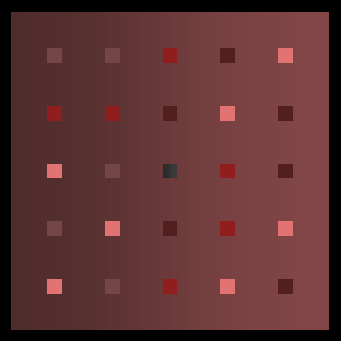
"Green tanuki"
The central square appears to be green, though it is monochromatic.
Copyright Akiyoshi Kitaoka 2005 (October 14)
*Tanuki is a wild animal like dog.

"Pink square 2"
The central square appears to be pink, though it is grey.
Copyright Akiyoshi Kitaoka 2005 (October 14)
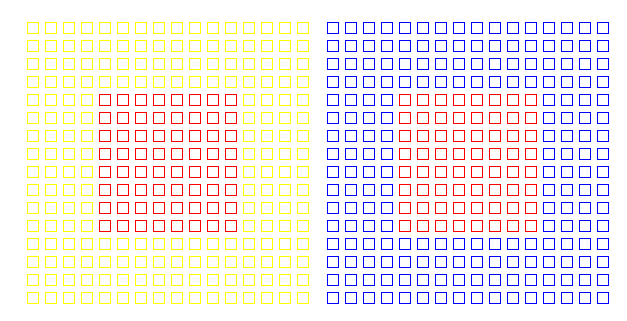
"Unattached color contrast"
The left red appears to be magenta while the right red appears to be orange, though they are identical.
Copyright Akiyoshi Kitaoka 2005 (September 30)
A comment from Ms. T. (September 30, 2005): The right red area appears to be larger than the left one.

"A stain"
There appears to be a yellow stain, though there are only blue or black gratings on the white background.
Copyright Akiyoshi Kitaoka 2005 (September 30)
Probably this is one variant of neon color spreading:
Van Tuijl, H. F. J. M. (1975). A new visual illusion: Neonlike color spreading and complementary color induction between subjective contours. Acta Psychologica, 39, 441-445.
Sohmiya, S. (2005) Explanation for neon color effect in achromatic line segments on chromatic inducers based on the multiple interprertation hypothesis. Perceptual and Motor Skills, 101, 267-282.
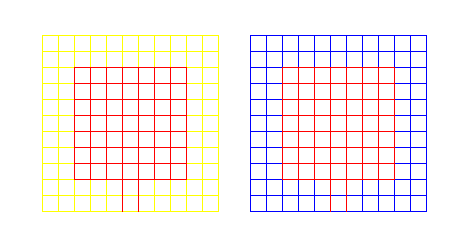
"Haetataki"*
*A tool to beat flies
The left red appears to be slightly bluish while the right red appears to be orange, though they are identical.
Copyright Akiyoshi Kitaoka 2005 (September 30)
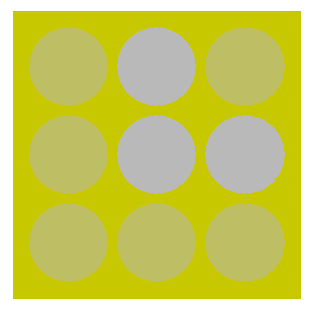
"Nine circles"
The three circles appear to be bluish, but they are actually gray (r = 185, g = 185, b = 185).
Copyright Akiyoshi Kitaoka 2005 (June 15)
Some observers correctly see them gray...

"Gold leaf"
The right and left square appear to be golden, but they are actually gray (r = 150, g = 150, b = 150).
Copyright Akiyoshi Kitaoka 2005 (June 15)
Some observers correctly see them gray...

"Hideouts"
After seeing this image for more than ten seconds, the nine gray (r = 95, g = 95, b = 95) squares appear to be golden. Moreover, the square we gaze at appears to be the most vivid.
Copyright Akiyoshi Kitaoka 2005 (June 11)
If you know reports that color contrast takes time to occur, let me know.
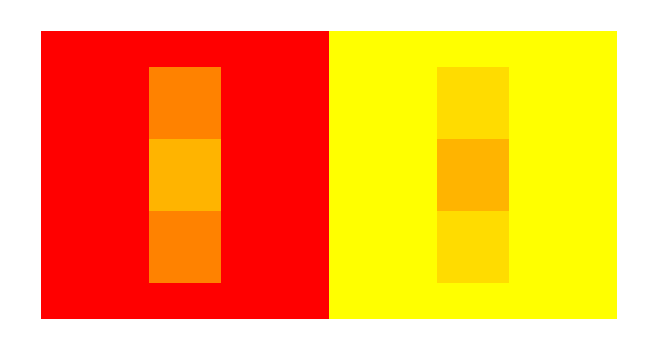
"Enhanced color contrast"
<Copyright free because this image should be a fundamental figure (Citation is necessary though)>
It appears that a = d or b = c in color, but actually b = d.

by Akiyoshi.Kitaoka 2005 (April 25)
This is not simply color contrast because removal of flanks reduces the effect (see the lower panel).

Stimulated by Piers' latest paper1)
1) Howe, P. D. L. (2005) White's effect: Removing the junctions but preserving the strength of the illusion. Perception, 34, 557 - 564.
If you find any images resembling my image in previous literature, please let me know. I will soon correct the description. Thank you.

"A flower garden"
The same red appears to be orange or magenta.
Copyright Akiyoshi Kitaoka 2002
in Trick Eyes, 2002
reproduced in May 27, 2005

"Ajisai"
(Japanese hydrangea)
The three squares aligned diagonally in the left are actually the same color as those aligned diagonally in the right, but the latter appear to be more reddish.
Copyright Akiyoshi Kitaoka 2005 (April 26)

"Lemon-yellow spiral and cream-colored spiral"
It appears as if there were a lemon-yellow spiral and a cream-colored spiral, but the colors are identical (= yellow: R255, G255, B0).
Copyright Akiyoshi Kitaoka 2005 (April 22)